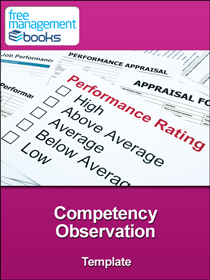
Competency Observation Template
This Competency Observation template allows you to record in greater detail how and when an individual displayed the required competencies as identified in their last appraisal.
The job of a manager includes many different facets. One of the most important areas that a manager must excel in is placing employees in the right position so that their abilities are used to their maximum potential. To do that successfully, a manager must properly evaluate the competencies of each and every member of their staff. This job is often easier said than done, and is something that can slip through the cracks if not given specific attention. If you are a manager that has a support staff responsible for accomplishing a certain set of tasks, correctly measuring the competencies of each and every team member will give you the best chance of success.
To start, we need to understand clearly what is meant by the work ‘competency’, and why it is important. In the workplace setting, competency typically refers to the abilities that an employee has that can be applied to the business as a whole. For example, a business degree from a quality university is not a ‘competency’. While it is a nice accomplishment to have on a resume, it does not say anything specific about what the employee has to offer you on a day to day basis. In fact, many of the things found of resumes will not end up being classified as competencies for your business once the employee starts work and is put to the test in real world conditions.
Competencies that matter to you as the manager are often difficult to put on paper, which is what makes the measurement part of the equation so difficult. Things like ‘strong negotiator’ or ‘good problem solver’ can be considered competencies that will be of real value to your department and the organization as a whole. The problem is that those things are not black and white, and you will have to use your skills as a manager of people to discover them and get that person in a position to be successful with the competencies that they do have.
So if they are hard to measure, how to you attempt to measure them? The process starts to highlighting what competencies you are looking for in your team or department setting. Every individual can bring many different talents, and you might get lost in the process if you don’t narrow down what you are looking for. Make a list of the competencies that you would like to see in each different position that reports to you. From there, you can start to see those skills manifested in your current employees, or going looking for those skills outside the team if necessary.
Ideally, you will collect a wide-range of competencies within one team. With a diverse team of employees in place, your team will be able to respond quickly to change and handle any task that it assigned with ease. This is one of the marks of a good manager – assembling a team of people whose competencies all complement each other and the end result is greater than the sum of the parts. While that is the end goal, it is built by paying attention to the specific talents of each employee on a day by day basis. When you have accumulated enough information to be confident in what all of your people can do, you can then make sure that each person is placed in the perfect role for them to excel.
Unfortunately, many managers stop the process of evaluating an employee the day they are hired. In fact, that is the day the evaluation should start – and it should never end. As people gain experience over time, their talents and competencies are likely to change. A good manager will note those changes and make sure to adapt accordingly. Get started right away by making a list of the competencies you need to find in your team of employees, and set about locating each of them so your team can become the cohesive unit it needs to be in order to succeed.
